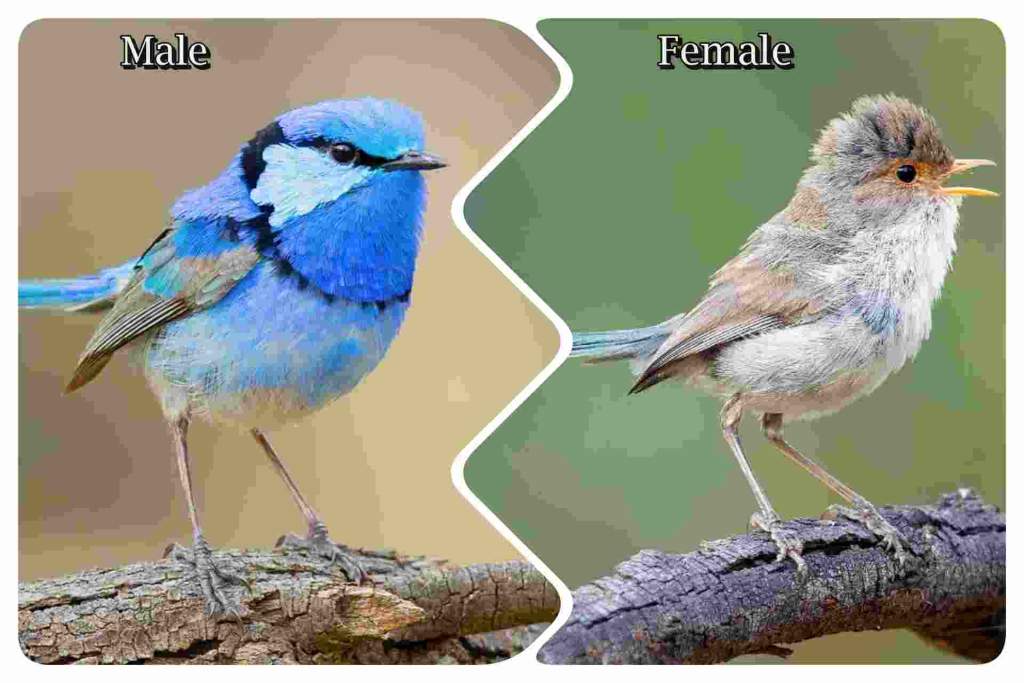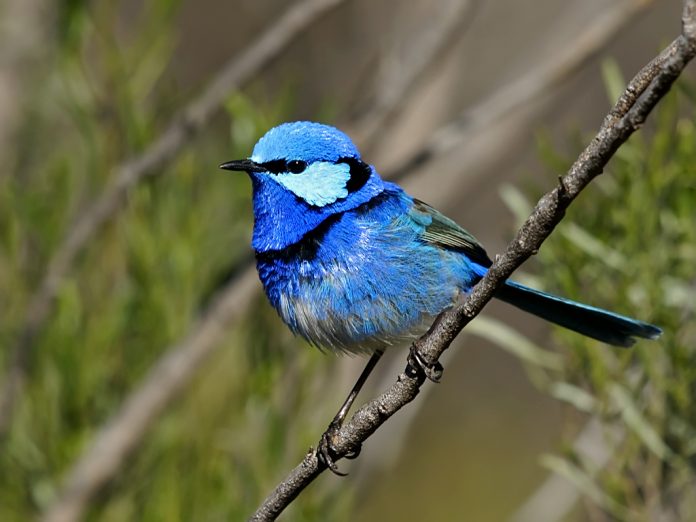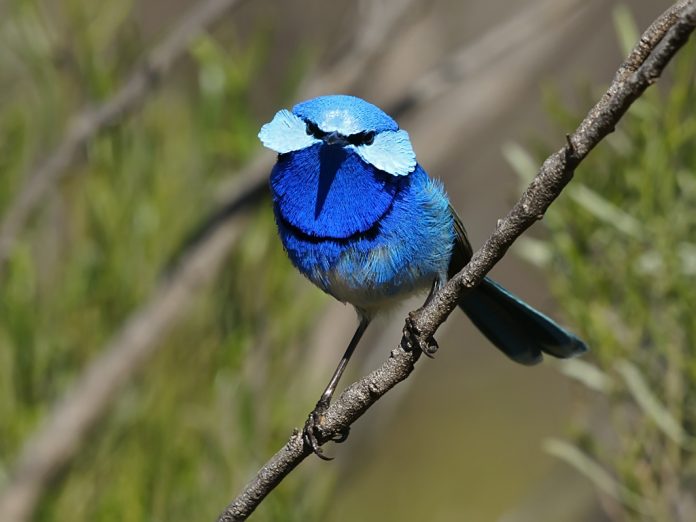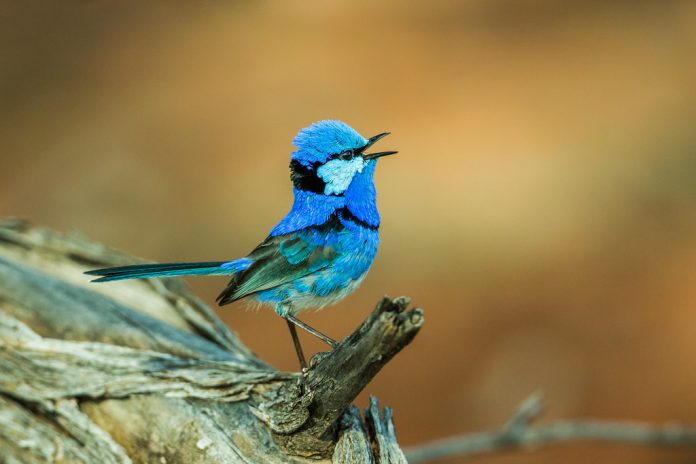The splendid fairywren (Malurus splendens) is a member of the Australasian wren family, Maluridae. The Splendid Fairywren (Malurus splendens) is in full breeding plumage; the male is a brilliant incandescent blue. It replaces the Superb Fairywren in the southwestern woodlands but is much less tolerant of human settlement and, at the same time, more adaptable to aridity; it ranges from the dry mulga Acacia scrubs of central Australia to the Mallee of inland eastern Australia. In most regions, it frequents rather close-canopied woodland with a fairly open understorey.
Like the Superb Fairywren, the splendid lives and breeds in small groups with helpers to attend to the nest and is sedentary, maintaining a territory year-round. Males, too, molt in and out of nuptial color in and out of breeding. All of the members of this group assist in both territorial and nest-site defense.
This allows the female to produce several broods. Female breeding for the first time produces more fledglings if she has helpers than if she does not. Groups of Splendid Fairy-wrens include additional adult females as well as adult males throughout the breeding season. Such a situation is rarely found in the Superb Fairywren. The female of the Splendid Fairywren does the entire nest building, incubating, and brooding of young.
Nests take several days to a week or more to finish, more quickly if there is an old nest nearby from which to scavenge material. New nests are built for each brood. If that year’s nesting was successful, everyone of the group—including the older siblings—fed the nestlings at the nest.
When nestlings are newly hatched, the female incubates them for long periods of time and intercepts the food brought to the nest, eating some herself and passing the remainder on to the young. Individuals develop different hunting capacities, so the larger the group, the more varied the catch brought to nestlings.
Every member of the group removes the fecal sac from each fledgling, carrying it at least 20 meters away from the nest before allowing it to fall. Of all the eggs laid in one breeding season, only about one-fifth produce young, which survive to the following winter.
Up to one-fifth of the nesting attempts may be parasitized by Horsfield’s Bronze Cuckoos as well. The young produced in any one year usually stay with their group throughout the winter, and some stay even longer. If the nest or young are threatened, the adults initiate a distraction display characteristic of all fairy-wrens.
They fluff their plumage, lower their tails, and run about like mice. The response is known as ‘rodent run’. In the west, the Splendid Fairywren lives in vegetation that is generally more densely shrubbed than its habitat in the center of Australia and further east. It feeds on a wide variety of insects that it catches as it forages, hopping around in loose groups, along the ground, and through and over small shrubs.
Sometimes it executes a ‘towering flight’, which involves making a sortie almost vertically from a bush to seize an insect meter above and then swooping back to cover. As they travel, Splendid Fairywrens cock their tails much less than other fairywrens and carry them generally at a lower angle.
During the day, feeding routines are broken with bouts of bathing, drinking, and mutual preening. When preening one another, groups cluster along a horizontal branch, working over their neighbors and leap-frogging into the center of the group to change partners. They also cluster together, side by side on a set horizontal branch in a high thicket, to sleep at night.
There are three distinctive races of the Splendid Fairywren: one dark cobalt with all cobalt back in the west; another sky-blue-headed and cheeked in central Australia; and the third mid-cobalt and black-backed in the east. All meet at the edges of their ranges and hybridize and intergrade there. It is also known as Banded Wren, Splendid Wren, Black-backed Blue Wren, and Turquoise Wren.
The size of a Splendid Fairywren is about 115–135 mm in length. The male bird is a dazzling medium-to-dark cobalt on the crown, mantle, wing coverts, and narrowly white-tipped tail. Lower back: dark cobalt (western race) or black (central and eastern races); scapulars: black.
The wings are gray-brown washed blue, but the cheek patch is a lighter blue than a crown, both sky-blue in the central race. The band around the nape to the lores and crossing breast is black. However, the underparts are uniformly deep cobalt (western race), violet on the throat and breast, and mid-blue on the belly (central race), or uniformly mid-cobalt with the center belly white (eastern race).
Their eyes are brown and black. The feet are normally dusky black. In non-breeding plumage, mid-to-gray-brown above, with a blue wash in wings; tail blue narrowly tipped white; dull white below, along with lores and bill dusky. Female: As a non-breeding male, lores and feathers around eye-washed rufous; wings plain grey-brown; tail blue-grey, tinged green. Bill is light brown; his feet are dusky brown. IMMATURES: As female but tail brown. During the first winter, males don nuptial plumage gradually.
The call of Splendid Fairywren is staccato, harshly trilled prip-prip in contact, repeated; high-pitched reed-like seeeee and churring in alarm; also brooding purr by the female. The Splendid Fairywren announces its territory and maintains group cohesion with many chirps before launching into a loud, rich, rippling warble that lowers in pitch.
The birds are bred mainly in September and January. They build a loose oval grass ball with an entrance two-thirds way upside, lined with plant fiber or feathers, and placed in a bushy shrub or twiggy branchlets up to 1, rarely two-to-three m above ground.
Eggs: usually three, sometimes two or four; white, spotted with red-brown; oblong oval, about 17 x 14 mm. The incubation period is 14–16 days for females. The chick fledges in 13–14 days. This bird can be found in healthy woodland, mulga, and mallee over the southwestern, central, and inland eastern mainland.











